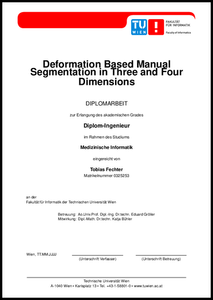Information
- Publication Type: Master Thesis
- Workgroup(s)/Project(s):
- Date: September 2011
- TU Wien Library:
- First Supervisor:
Abstract
Segmentation of medical image data has grown into one of the most important parts in medicine during the past years. The main fields of segmentation in the area of medicine are surgicalplanning, diagnosis, therapy-planning and simulation. The focus was in the last years mainly on automatic and semi-automatic segmentation methods for 3D and 4D datasets. Most of them are highly specialized as they need a lot of prior knowledge and often the results, especially in presence of pathologies or other abnormalities, have to be corrected manually. An alternative to automatic and semi-automatic methods is to perform the segmentation manually. The main drawbacks of this approach are that it is very tedious and time consuming, the user knowledge has a very high impact on the results and it is very hard to reproduce specific results. This work presents a tool that enables the user to enhance results of automatic and semiautomatic algorithms and to do fast manual segmentation of shapes of arbitrary topology from scratch. The tool can deal with three and four dimensional image datasets captured by different modalities. The segmentation is mesh based and performed with a 2D cut approach. With the use of this approach the user aligns a 2D cut through the mesh to the shape to segment but in the background the 3D mesh gets deformed. To achieve a better alignment of the edges to a specific shape the edge class based Sticky Edges algorithm is introduced. Furthermore, well known mesh optimization algorithms like subdivision, smoothing and decimation were implemented to accomplish better results. To achieve a faster segmentation of four dimensional datasets two methods are presented. With the first one the user can record its interactions on one volume in the 4D dataset and apply them automatically to the other volumes. The other one enables the user set an already segmented mesh as start position for the segmentation of other volumes. The approach presented in this work is up to 25 times faster than the Livewire approach [41] that was used to evaluate this tool. Moreover, the mesh quality regarding smoothness, curvature and triangle quality are at eye level with the evaluation meshes. The geometric distance to the ground truth meshes is on average 2 mm and the normal deviation is between 0.3 and 0.4 degree. To sum up, this master thesis introduces a tool for fast manual image segmentation that provides proper mesh quality.Additional Files and Images
Weblinks
No further information available.BibTeX
@mastersthesis{Fechter_2011_DBS,
title = "Deformation Based Manual Segmentation in Three and Four
Dimensions",
author = "Tobias Fechter",
year = "2011",
abstract = "Segmentation of medical image data has grown into one of the
most important parts in medicine during the past years. The
main fields of segmentation in the area of medicine are
surgicalplanning, diagnosis, therapy-planning and
simulation. The focus was in the last years mainly on
automatic and semi-automatic segmentation methods for 3D and
4D datasets. Most of them are highly specialized as they
need a lot of prior knowledge and often the results,
especially in presence of pathologies or other
abnormalities, have to be corrected manually. An alternative
to automatic and semi-automatic methods is to perform the
segmentation manually. The main drawbacks of this approach
are that it is very tedious and time consuming, the user
knowledge has a very high impact on the results and it is
very hard to reproduce specific results. This work presents
a tool that enables the user to enhance results of automatic
and semiautomatic algorithms and to do fast manual
segmentation of shapes of arbitrary topology from scratch.
The tool can deal with three and four dimensional image
datasets captured by different modalities. The segmentation
is mesh based and performed with a 2D cut approach. With the
use of this approach the user aligns a 2D cut through the
mesh to the shape to segment but in the background the 3D
mesh gets deformed. To achieve a better alignment of the
edges to a specific shape the edge class based Sticky Edges
algorithm is introduced. Furthermore, well known mesh
optimization algorithms like subdivision, smoothing and
decimation were implemented to accomplish better results. To
achieve a faster segmentation of four dimensional datasets
two methods are presented. With the first one the user can
record its interactions on one volume in the 4D dataset and
apply them automatically to the other volumes. The other one
enables the user set an already segmented mesh as start
position for the segmentation of other volumes. The approach
presented in this work is up to 25 times faster than the
Livewire approach [41] that was used to evaluate this tool.
Moreover, the mesh quality regarding smoothness, curvature
and triangle quality are at eye level with the evaluation
meshes. The geometric distance to the ground truth meshes is
on average 2 mm and the normal deviation is between 0.3 and
0.4 degree. To sum up, this master thesis introduces a tool
for fast manual image segmentation that provides proper mesh
quality.",
month = sep,
address = "Favoritenstrasse 9-11/E193-02, A-1040 Vienna, Austria",
school = "Institute of Computer Graphics and Algorithms, Vienna
University of Technology ",
URL = "https://www.cg.tuwien.ac.at/research/publications/2011/Fechter_2011_DBS/",
}

 Thesis
Thesis
